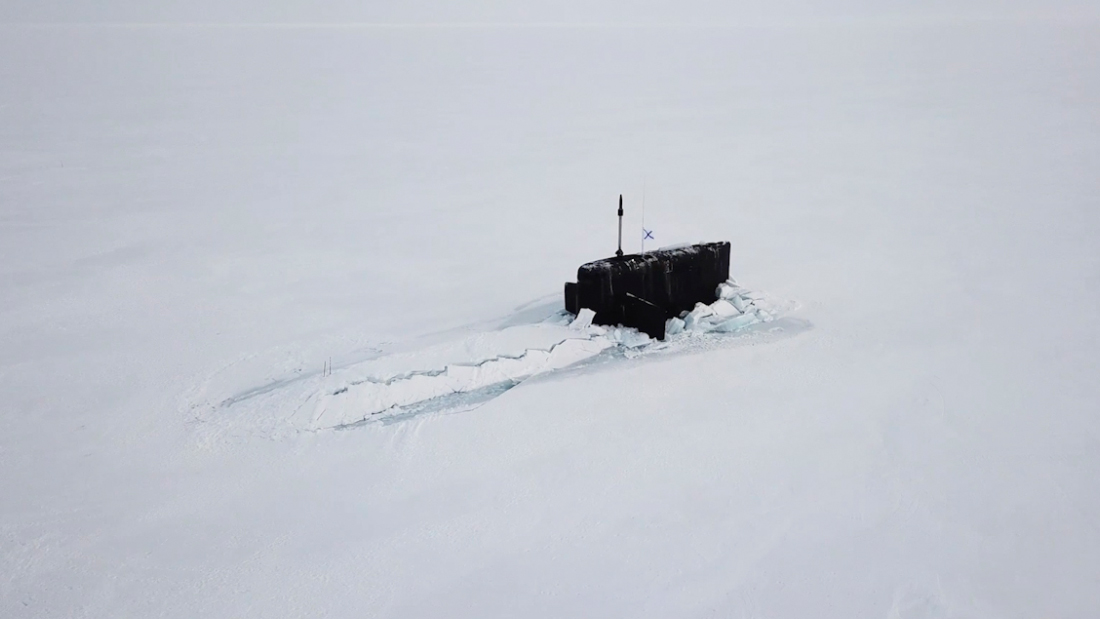3 Russian nuclear submarines simultaneously punch through Arctic ice
Here's why the naval maneuver is so tricky.

Three Russian navy submarines punched their way through several feet of sea ice in the Arctic to surface simultaneously within a few hundred feet of each other — one of the first times the tricky naval maneuver has been achieved.
A video released by Russia's Ministry of Defence shows the conning towers of the three subs breaking through a continuous sheet of floating ice near the Franz Josef Land archipelago, in the Arctic Ocean north of the Barents Sea.
The subs are taking part in Umka-2021 (meaning "polar bear" in the Siberian Chukchi language) — an expedition to the region that involves 600 military and civilian personnel, including staff from the Russian Geographical Society, a non-governmental organization established in the 19th century.
Related: 7 technologies that transformed warfare
The three submarines broke through 5-foot-thick (1.5 meters) ice to surface within 1,000 feet (300 m) of each other at the same time, "for the first time in the history of the Navy," Russian navy commander Admiral Nikolay Yevmenov told Russia's President Vladimir Putin in a televised video call.
The conditions in the region were between minus 13 and minus 22 degrees Fahrenheit (minus 25 and minus 30 degrees Celsius), with winds gusting at up to 70 mph (110 km/h), the admiral reported.



Surface submarines
Surfacing a submarine through thick sea ice is no easy feat. According to a 2018 article in Popular Mechanics about American submarines in the Arctic, bursting through the ice requires careful preparation.
Get the world’s most fascinating discoveries delivered straight to your inbox.
Nuclear-powered missile submarines usually try to stay hidden beneath Arctic ice because it makes them effectively invisible to enemies. But when they do have to come to the surface, a sub commander will first try to find nearby patches of open water — such as a "lead" or "polynya" — where they can surface without encountering any floating ice.
Related: Could the US stop nuclear weapons?
When that fails, careful maneuvering is needed so that the submarine can break through up to 9 feet (2.5 m) of sea ice.
The first task is to slowly raise the submarine until its upper tower makes contact with the bottom of the floating ice layer. Compressed air is then used to push seawater out of the submarine's ballast tanks, creating an upward force, until that force cracks the ice.
Getting three submarines to break through the ice at the same time is especially difficult, because the underwater vessels can't communicate with each other.
Arctic expedition
Although this is the first time Russian submarines have surfaced through the ice together, it may not be the first time it has been done.
Popular Mechanics reported that two U.S. submarines — the USS Connecticut and the USS Hartford — surfaced through the Arctic ice within sight of the British submarine HMS Trenchant in 2018.
Russia's military didn't name the three vessels that took part in the latest operation, but the Barents Observer news site identified them as two Delta-IV nuclear-powered ballistic missile submarines — the mainstay of the Soviet submarine fleet during the Cold War — and a newer Borei-class sub; the class names comes from Boreas, the Greek god of the north wind.
Each Russian submarine is thought to carry up to 16 ballistic missiles, and each missile can carry up to six individual nuclear warheads.
The Umka-2021 expedition near Russia's Franz Josef Land archipelago began on March 20 under the command of the Russian navy.
"For the first time, according to a single concept and plan, a complex of combat training, scientific research and practical measures of various directions is being carried out in the circumpolar regions," Yevmenov told Putin in the video call.
A key result was that the "technical characteristics" of various weapon systems, military equipment and special equipment had been confirmed in conditions of high latitude and low temperatures, he said.
Russia has proposed that the Arctic could become a major route for commercial shipping, which could be shepherded through the sea ice by nuclear-powered "icebreaker" ships.
Originally published on Live Science.
Tom Metcalfe is a freelance journalist and regular Live Science contributor who is based in London in the United Kingdom. Tom writes mainly about science, space, archaeology, the Earth and the oceans. He has also written for the BBC, NBC News, National Geographic, Scientific American, Air & Space, and many others.


